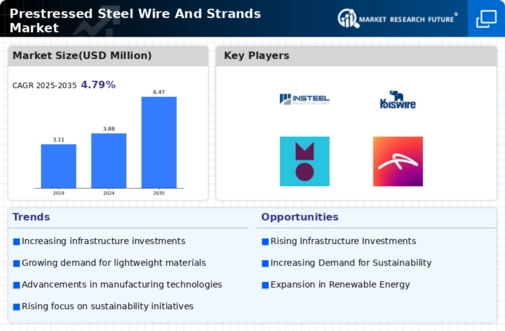Market Trends
Key Emerging Trends in the Prestressed Steel Wire Strands Market
The global issue of global warming is wreaking havoc on the environment, making it imperative to adopt measures that can effectively mitigate its impact. One highly effective strategy in this regard is enhancing energy efficiency in the construction sector. By reducing the consumption of natural resources, land, raw materials, and energy in the construction of buildings, a substantial decrease in greenhouse gas (GHG) emissions can be achieved. This approach aligns with the broader goal of creating structures that are not only high-performing but also environmentally friendly. Among the materials contributing to this cause is prestressing steel strand coated with epoxy, recognized for its cost-effectiveness and time-saving attributes in concrete projects.
The significance of energy efficiency is underscored by the achievements of programs such as the Energy Star Programme. In 2020, approximately 6,500 commercial buildings earned the ENERGY STAR label, resulting in savings of USD 1.6 billion and the prevention of more than 5 million metric tons of GHG emissions. ENERGY STAR certified buildings, on average, consume 35% less energy compared to typical buildings nationwide. Over 800 companies have partnered with the EPA's Energy Star program, representing a diverse range of industrial sectors, including food industries, bakeries, steel mills, petroleum refineries, and pharmaceutical plants. Notably, studies reveal that Energy Star certified buildings command a premium of up to 16% for both sales and rental rates.
The impact of energy-efficient construction practices is not limited to developed nations. In India, where buildings account for over 30% of electricity consumption, there is a growing realization of the importance of adopting energy-efficient measures. Moreover, considering that two-thirds of the buildings that will exist in India by 2030 are yet to be constructed, the opportunity to incorporate energy-efficient technologies is substantial. The rapid pace of urbanization in recent years has led to a significant expansion of urban building floor area, thereby increasing the demand for prestressing steel.
The demand for prestressing steel wire and strands is expected to surge in the coming decades, driven by the ongoing trend of urbanization and the pressing need to address energy security and GHG emissions. The construction industry's reliance on prestressing steel underscores its role not only in ensuring structural integrity but also in contributing to sustainable and environmentally conscious building practices. As the world grapples with the challenges posed by climate change, the adoption of energy-efficient construction materials like prestressing steel emerges as a crucial step toward creating a more sustainable and resilient future. By embracing these technologies, the construction industry can play a pivotal role in mitigating the environmental impact of global warming and fostering a more sustainable built environment for future generations.







Leave a Comment